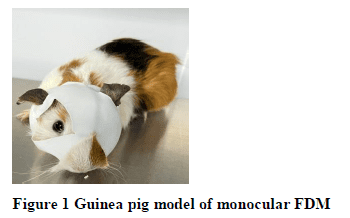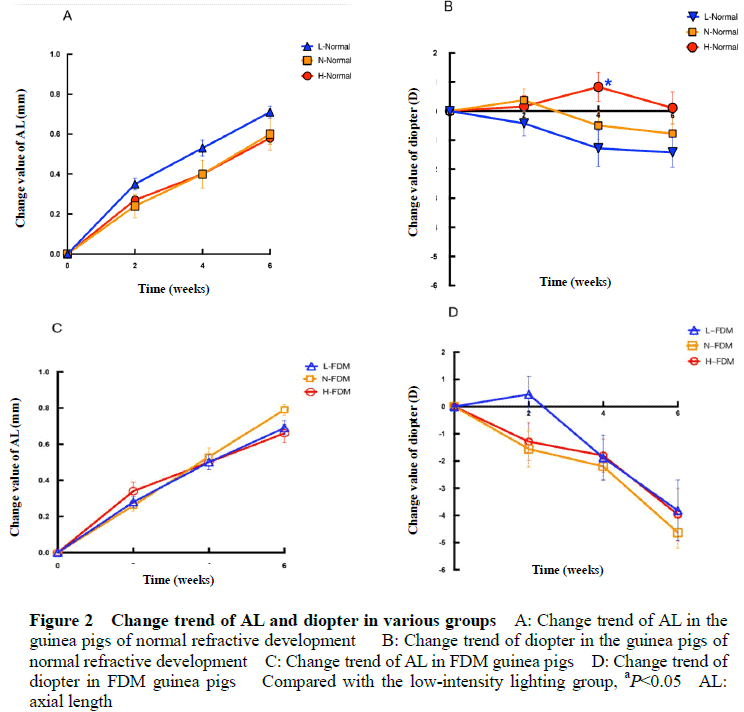Abstract [View PDF] [Read Full Text]
Objective
To investigate the effects of different intensity of lighting on normal refractive development and form deprivation myopia (FDM) in guinea pigs.
Methods
A total of 108 healthy 3-week-old guinea pigs were divided into normal refractive development guinea pigs (n=54) and FDM guinea pigs (n=54). FDM models were prepared in FDM animals by occlusion of the left eyes using an opaque mask, and the bilateral eyes were open in the normal refractive development guinea pigs.The guinea pigs were randomized to low (20 lx), normal(300 lx), and high intensity-lighting (5 000 lx) groups with a 12-hour light/12-hour dark cycle for 6 consecutive weeks under LED light.The ocular biometry was performed in a two-week interval.Axial length (AL) and dilated diopter were measured by A-scan ultrasonography and retinoscopy, respectively, and were compared after different lighting durations, and the change trends of them in normal refractive development and FDM guinea pigs were evaluated.
Results
The AL values were not significantly different among low, normal and high intensity-lighting groups (Fgroup=0.365, P=0.697), and the AL was gradually prolonged over the lighting duration (Ftime=353.750, P<0.001). The diopters showed a statistically significant difference among different intensity-lighting groups (Fgroup=3.576, P=0.034). The diopter in high intensity-lighting for 4 weeks was (+ 2.75±2.15) D, which was significantly higher than (0.41±3.07) D in the normal refrective development guinea pigs (P<0.001). In the FDM guinea pigs, both AL and diopter were not significantly different among low, normal and high intensity-lighting groups (Fgroup=0.105, P=0.900; Fgroup=0.973, P=0.387), and significant differences were seen in AL and diopter among three groups (Ftime=408.302, 27.407; both at P<0.001). The diopter in FDM eyes of low intensity-lighting for 2 weeks was (+ 2.35±1.95) D, which was higher than (+ 1.90±0.97) D before lighting, with no statistically significant difference between them (P>0.05). The AL was shortest and the AL change was smallest in normal refractive development guinea pigs of high intensity-lighting group.The diopter change in FDM guinea pigs of the low intensity-lighting group was significantly smaller than that in the normal intensity-lighting group (P<0.001), with a transient hyperopia drift.
Conclusions
The 5 000 lx lighting can slow down the development toward myopia in the normal refractive development eyes, and 20 lx lighting tends to delay the progression FDM eyes with a hyperopic shift after lighting for 2 weeks.
Key words:
Myopia; Lighting; Refraction, ocular; Development; Form-deprivation; Biometry
Figures and tables






Contributor Information
Beijing Tongren Hospital Tongren Eye Center, Capital Medical University, Beijing Ophthalmology &
Visual Science Key Lab, Beijing 100730, China
Beijing Tongren Hospital Tongren Eye Center, Capital Medical University, Beijing Ophthalmology &
Visual Science Key Lab, Beijing 100730, China
Beijing Tongren Hospital Tongren Eye Center, Capital Medical University, Beijing Ophthalmology &
Visual Science Key Lab, Beijing 100730, China
Beijing Tongren Hospital Tongren Eye Center, Capital Medical University, Beijing Ophthalmology &
Visual Science Key Lab, Beijing 100730, China
Beijing Tongren Hospital Tongren Eye Center, Capital Medical University, Beijing Ophthalmology &
Visual Science Key Lab, Beijing 100730, China
Beijing Tongren Hospital Tongren Eye Center, Capital Medical University, Beijing Ophthalmology &
Visual Science Key Lab, Beijing 100730, China
Beijing Tongren Hospital Tongren Eye Center, Capital Medical University, Beijing Ophthalmology &
Visual Science Key Lab, Beijing 100730, China
Department of Ophthalmology, Beijing Anzhen Hospital, Capital Medical University, Beijing 100029, China
Beijing Tongren Hospital Tongren Eye Center, Capital Medical University, Beijing Ophthalmology &
Visual Science Key Lab, Beijing 100730, China